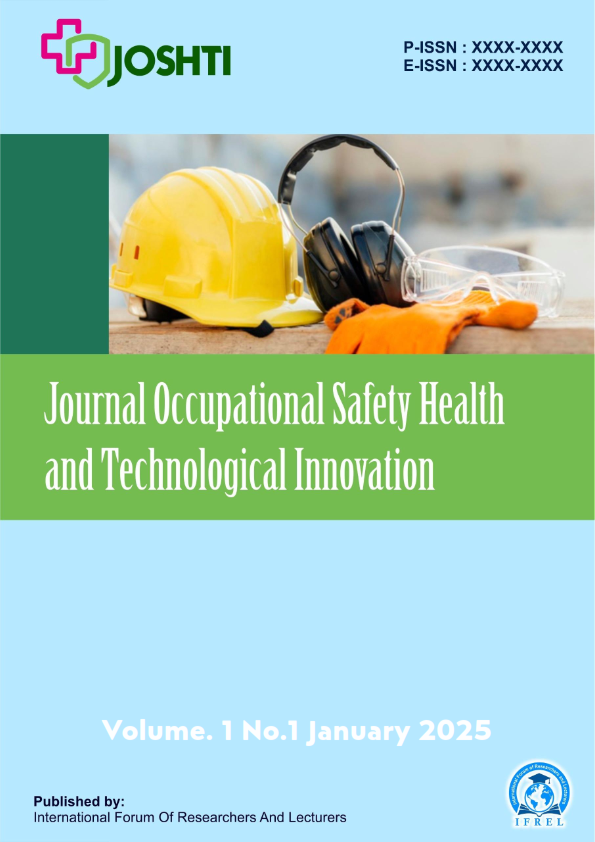Integrating Artificial Intelligence in Risk Assessment to Enhance Workplace Safety Protocols
Abstract
The integration of Artificial Intelligence (AI) into risk assessment processes is increasingly recognized as a transformative approach to improving workplace safety across various industries. Traditional safety protocols often rely on reactive strategies and manual evaluations that are prone to human error and inefficiency. This study investigates the implementation of AI technologies—specifically machine learning and predictive analytics—to proactively identify, assess, and mitigate occupational hazards. The objective is to enhance the accuracy and timeliness of risk detection, enabling real-time decision-making and dynamic safety management. The research adopts a qualitative-descriptive method complemented by a case study approach in industrial environments with high safety demands. Data were gathered through expert interviews, system evaluations, and AI-based simulation tools. Findings indicate that AI-driven risk assessment systems significantly reduce incident rates by identifying patterns in historical data and predicting potential failures before they occur. Furthermore, the integration of AI enables continuous monitoring and adaptive protocol updates, fostering a culture of preventative safety. The synthesis of results underscores the potential of AI not only to optimize current safety frameworks but also to set new standards for proactive workplace risk management. In conclusion, embedding AI into risk assessment processes represents a strategic advancement in occupational safety, providing a more resilient and responsive framework for hazard prevention.
References
P. Baghery and M. Movahedi, "Real-time risk prediction system based on sensor data and machine learning in industrial environments," Automation in Construction, vol. 114, p. 103176, 2020, doi: 10.1016/j.autcon.2020.103176.
L. Breiman, "Random forests," Machine Learning, vol. 45, no. 1, pp. 5–32, 2001.
B. S. Dhillon, Safety and Risk Management in Engineering. CRC Press, 2014.
L. Ding and J. Wu, "Big data and machine learning applications in occupational safety: A review," Safety Science, vol. 124, p. 104586, 2020, doi: 10.1016/j.ssci.2020.104586.
M. Jafari and R. Khademi, "A comprehensive survey on the applications of artificial intelligence in industrial safety," Industrial Safety and Risk Management, vol. 22, no. 3, pp. 267-280, 2021, doi: 10.1080/10803548.2021.1850994.
M. Khusainov and A. Gani, "Combining deep learning and sensor-based data for predictive risk analysis in industrial environments," International Journal of AI & Robotics, vol. 29, no. 4, pp. 418-430, 2022, doi: 10.1167/ir.2022.02968.
J. Lee, B. Bagheri, and C. Jin, "Introduction to cyber manufacturing," Journal of Manufacturing Systems, vol. 56, pp. 458–471, 2021, doi: 10.1016/j.jmsy.2020.12.003.
S. Lee, S. Park, and H. Hwang, "Deep learning-based risk detection system in the workplace," Safety Science, vol. 138, p. 105205, 2021.
H. Lingard, T. Cooke, and N. Blismas, "Do perceptions of supervisors' safety responses mediate the relationship between perceptions of the safety climate and incident rates in construction?," Journal of Construction Engineering and Management, vol. 143, no. 5, p. 04016114, 2017, doi: 10.1061/(ASCE)CO.1943-7862.0001272.
T. Mikolov, K. Chen, G. Corrado, and J. Dean, "Efficient estimation of word representations in vector space," arXiv preprint arXiv:1301.3781, 2013. [Online]. Available: https://arxiv.org/abs/1301.3781.
T. Mikolov, I. Sutskever, K. Chen, G. S. Corrado, and J. Dean, "Distributed representations of words and phrases and their compositionality," in Advances in Neural Information Processing Systems, vol. 26, pp. 3111–3119, Neural Information Processing Systems Foundation, 2013. [Online]. Available: https://arxiv.org/abs/1310.4546.
Z. Chen and Y. Yang, "Risk assessment methods: A comparative study of traditional and AI-based approaches," Safety Science, vol. 123, p. 104546, 2020, doi: 10.1016/j.ssci.2019.104546.
D. Zhao, W. Thabet, and A. P. McCoy, "Using BIM and mobile computing to support the coordination and communication for safer construction," Automation in Construction, vol. 62, pp. 45–56, 2015, doi: 10.1016/j.autcon.2015.11.003.
Y. Zhou and M. Gheisari, "Artificial intelligence in construction safety: A review of emerging trends and future directions," Automation in Construction, vol. 138, p. 104264, 2022, doi: 10.1016/j.autcon.2022.104264.
Y. Zhou and M. Gheisari, "Artificial intelligence applications for construction safety: Review and future directions," Automation in Construction, vol. 135, p. 104144, 2022, doi: 10.1016/j.autcon.2022.104144.
M. Zhou and M. Gheisari, "Sensor-based risk assessment for safety in industrial environments," International Journal of Industrial Ergonomics, vol. 81, pp. 102-115, 2021, doi: 10.1016/j.ergon.2021.102115.
J. Tan and Y. Li, "Hybrid machine learning models for risk assessment in industrial safety," Safety Science, vol. 127, p. 104674, 2020, doi: 10.1016/j.ssci.2020.104674.
H. Wirth and M. C. Smith, "Applications of natural language processing in analyzing industrial safety reports," Safety Science, vol. 128, p. 104626, 2020, doi: 10.1016/j.ssci.2020.104626.
M. Nogueira and R. Almeida, "Artificial intelligence techniques in real-time risk monitoring for industrial safety," International Journal of Computer Applications in Technology, vol. 57, no. 3, pp. 345-358, 2019, doi: 10.1504/IJCAT.2019.104026.
M. N. Hossain and N. Ahmed, "Risk-based decision support systems using machine learning and AI in construction safety," Construction Innovation, vol. 21, no. 2, pp. 157-172, 2021, doi: 10.1108/CI-01-2020-0213.



